by Winding Pathways | Oct 31, 2024 | Nature, Reflections/Profiles, Trees
A national forest amid Nebraska’s grassy Sand Hills! Yup. Several units of the Nebraska National Forest are scattered about the central and northwestern part of the state.
In the 1990s we drove through miles of grassland with nary a tree in sight and then camped in a sprawling forest of Ponderosa pines and red cedars in the Forest’s Bessey Unit almost dead center in the Cornhusker State. How can there be a forest on land that nature intends to be a prairie?
-
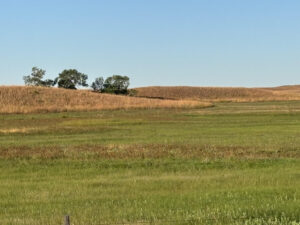
-
Nebraska grasses and fields.
-
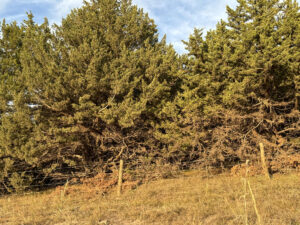
-
Fire spreads easily when branches touch
History
In 1902 University of Nebraska botanist Charlesy Bessey encouraged Forest Service Chief Gifford Pinchot and President Theodore Roosevelt to plant trees and create a forest in the grassy Sand Hills. The nation was facing a lumber shortage and most Americans valued forests over prairies and deserts, so they agreed.
Efforts
Millions of trees were planted close together over the 90,000-acre Bessey Unit. Many grew well; when we visited 30 years ago, they were mature and gorgeous.
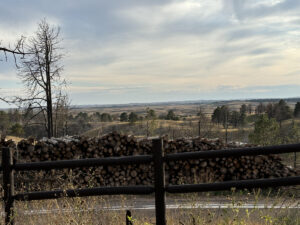
Rolling hills along the Loup River.
A fire tower was also built and staffed to watch for fires. Sure enough, fires broke out and killed many of the trees. Fire is an efficient sorter. Grass is highly fire-resistant. Many trees are not.
Return to Nebraska’s National Forest
Decades later we camped there again in September 2024 and were amazed at the change. Although the Forest Service Campground remains in trees, much of the former forest has quickly returned to grassland, due to several fires.
We saw thousands of dead trees with stacks of trunks piled along the road.
-
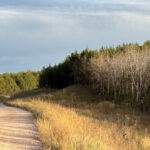
-
Grasses line a dirt road
-
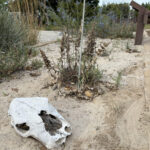
-
Nebraska’s grassland sandy soil.
-
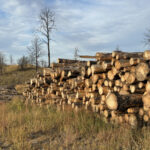
-
Recovering dead trees.
Lesson
Attempting to create a forest in a grassland was an ecological disaster. Over time nature is reclaiming land that should have been managed for what it is – healthy grass sprinkled with millions of wildflowers.
Continued Activity
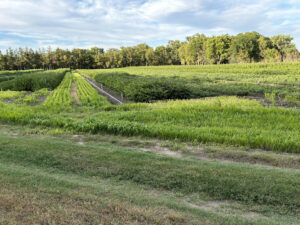
Trees grow in the nursery
The Bessey Unit includes a modern nursery where the Forest Service grows trees for replanting on land in the western United States. The surrounding land is a fascinating place to see first-hand the result of past management based on a misunderstanding of the environment.
The campground’s trees were spared fire and remain a shady place to camp for anyone driving across vast Nebraska. Great opportunities exist here for education and enjoyment of the trails. But, it needs maintenance. So does the now abandoned fire tower. For information check usda.gov/nebraska.
by Winding Pathways | Jun 20, 2024 | (Sub)Urban Homesteading, Energy Efficiency, Nature, Trees
Connecting With Wood
Although we rarely watch sports on TV, the 2024 Iowa Women’s Basketball team captivated us. With athletic sneakers squeaking up and down the wood floor, Caitlin Clark’s sharpshooting and Hanna Stuelke’s blocks were amazing.
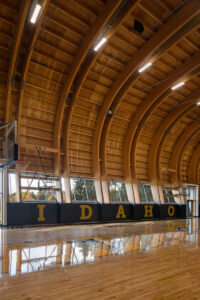
ICCU Arena Photography by Lara Swimmer. Images use restricted. Use by permission only.
About a month after the season, we entered an elite new basketball arena. Neither Caitlin nor Hanna was there, but we bet they’d love playing in a gorgeous new venue crafted mostly of wood. It’s on the University of Idaho campus.
“The arched ceiling beams are strong, beautiful, and crafted of local Douglas Fir and larch,” said Dean of the University’s College of Natural Resources, Dennis Becker, as he guided us through the University’s Idaho Central Credit Union (ICCU) Arena. It opened in October 2021 after about two years of construction and several more of planning and fundraising. Remember, this was during the Pandemic!
Modern, Flexible, and Beautiful Venue
After playing in the nearly century-old Memorial Gym and a few years in the massive Kibbe Football Dome, the University sought to create a gorgeous and flexible venue that enabled players and spectators to enjoy the intimacy of a largely wooden building that connects spectators with nature. Building it drew on the college’s academic strengths in forestry and wood technology, architecture, engineering, and athletics.
“Much of the wood used to create it came from the University’s Experimental Forest. In addition to being elegant its beams of laminated wood are sturdy, fire resistant, and gorgeous,” continued Dean Becker.
-
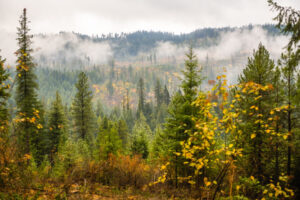
-
Logging and Maintenance at the Experimental Forest
-
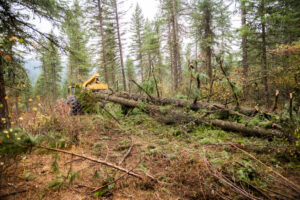
-
Selective logging
The Dean later explained that the reason the building feels warm and comfortable may be a concept expressed by Erich Fromm to describe the biological orientation humans have with all that’s alive and vital. Biophilia was expressed by the late Harvard professor E.O. Wilson as an affiliation people have with other life forms and nature as a whole, which is rooted in our biology.
-
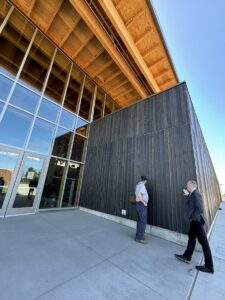
-
Gorgeous and modern
-
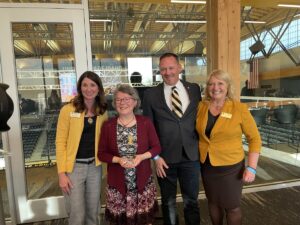
-
Courtside in background
-
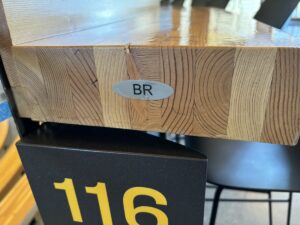
-
Variety of woods
Connecting to Wood
Perhaps biophilia made us feel comfortable immediately after entering the Arena as it does in our Iowa home. In both places, we enjoy being enveloped in wood.
We recently visited friends in their brand-new home. Although functional and low maintenance, something about it was mildly uncomfortable. Crafted almost entirely of human-made products the home had doors of plastic, flooring of artificial planking, and walls of plaster. Even the cabinets were plastic. It lacked wood.
In contrast, our 1947-era home replete with wood feels cozy. Floors are white oak and Douglas fir with beams and rafters of pine, fir, and cedar. Our tables were crafted from red oak and black walnut and on the fireplace mantle is a polished cross-section of an oak crotch and a leaf carved from silver maple wood.
What Is It About Wood?
We love wood. It’s gorgeously individualistic. No two boards are exactly the same. It projects a warm and comforting feeling while having environmental benefits. Sustainably managed forests allow land to continually produce wood forever. It is also easy to reuse or repurpose.
Last winter we hired a company to refurbish our downstairs bathroom of easy-to-clean plastic and vinyl. It functions well, but something about it didn’t feel right. No wood. So, Rich bought a half-inch thick oak board, cut it to fit, finished it with a soft finish, and nailed it to a ceiling beam. That single piece of wood made the bathroom more comfortable.
Whether in a home or the University of Idaho’s Idaho Central Credit Union Arena, the beauty and function of wood make us feel at home.
-
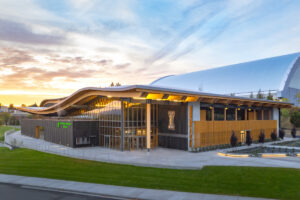
-
ICCU Arena exterior drone shots
-
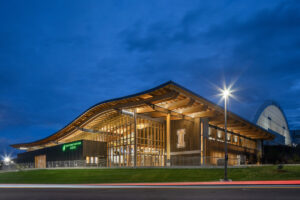
-
ICCU Arena photography by Lara Swimmer. Images use restricted. Use by permission only.
This is one of a three-part series of blogs stemming from a recent visit to our alma mater, the University of Idaho. The school offers an array of majors and is located in the rolling farmland of the Palouse and nestled below Moscow Mountain. For information check out uidaho.edu. Its College of Natural Resources offers majors ranging from wildlife biology to outdoor recreation, and forestry. It’s where Rich graduated. Marion received her MS from the Idaho College of Education, which features a variety of degrees, including movement science.
by Winding Pathways | Mar 21, 2024 | Garden/Yard, Garden/Yard, Trees
Bright! Beautiful! Ominous!
As we walked across a New Jersey parking lot last summer an amazingly colorful, and new-to-us, insect fluttered in front of us. It had a gorgeous creamy white and bright red body covered with black spots.
Identifying it was easy and ominous. It was a Spotted Lanternfly. First found in Pennsylvania in 2014 it likely came to the United States from its native China as a hitchhiker in a crate or box.
It may be a pretty bug but its presence is ominous. It feeds on at least 172 different plant species and is spreading rapidly westward from its start close to the Atlantic Ocean.
Feeding off Another Invasive
What’s somewhat ironic about the lanternfly is the insect’s affinity for another Chinese invasive, the Tree of Heaven or Ailanthus. Although the inch-long insect will eat many different plants it prefers this highly aggressive and fast-growing tree.
Important Contact Information
The Iowa Department of Agriculture and Land Stewardship is on the lookout for the Spotted Lanternfly. They ask anyone spotting one in Iowa to report it by calling:
l (515)725-1470 or logging onto their website at IowaAgriculture.gov.
How To Reduce the Invasion
A key to reducing this insect’s abundance may be reducing Ailanthus tree numbers. This invasive tree thrives in urban and rural areas, often forming large groves. It displaces native trees, has little commercial value, and now harbors an introduced insect pest.
Winding Pathways encourages anyone with an Ailanthus in their yard to remove it, convert it to firewood if you can, and replace it with a native tree species. Remember, report any Spotted Lanternflies you spot.
-
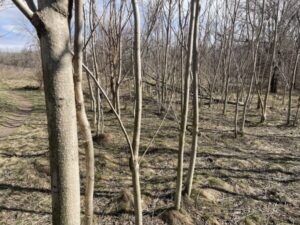
-
Grove of young Ailanthus.
-
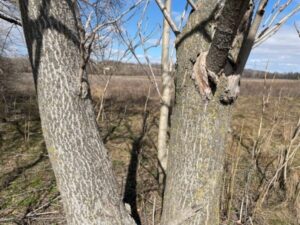
-
Ailanthus trees grow fast.
by Winding Pathways | Feb 29, 2024 | (Sub)Urban Homesteading, Home Improvements, Nature, Trees
Knot Just Lumber
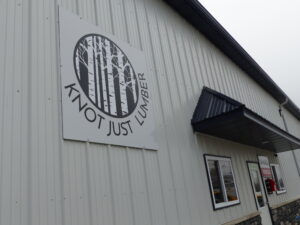
A local store
When driving through Hiawatha, Iowa, recently, a nondescript sign caught our eye. Posted on what looked like a warehouse the sign said, KNOT JUST LUMBER. We had to check it out and soon entered the ultimate wood candy store.
Leaning upright were immense slabs of white and red oak, walnut, cherry, and mulberry destined to become gorgeous tables. Nearby were smaller boards of at least a dozen tree species. Most were cut from native Iowa trees, but some racks held exotic wood from foreign lands. Purpleheart caught our eyes. It comes from trees that grow in Central and South America. When first cut the wood is dull grayish but within a few days, it transforms into an eggplant purple color.
Local Connections
We returned to visit Nic Carter, who co-owns the store with his sister, Caris. The family is from Alburnett and Nic was an active 4-H member dabbling in woods making jewelry boxes for art shows. After stints as a woodworker and home builder Nic, and his family opened Knot Just Lumber in September 2022. He and his sister decided to open the store because, “The area has no local woodworking place, so, I started one here,” he explained.
His father and son help run this family-owned and operated business located just north of Cedar Rapids. We enjoyed an in-person tour, which is augmented by their website and includes a virtual walk-through.
Knot Just Lumber caters to hobbyists, commercial customers, and families. We have visited several times and enjoyed chatting with individual customers and couples, and watched kids touch and smell the smooth, fragrant wood. The company buys trees from wood brokers. Most originate from trees in southern Iowa. The company mills wood into various-sized boards and turning rounds, dries it in an onsite kiln, surface planes, and sands most boards.
Wood is Special
Wood is special. We’ve noticed that in many brand-new houses doors, window frames, and floors are crafted from composite materials and plastic.
Nothing seems natural. In contrast, our 1947-era house has floors of Douglas Fir and White Oak with our furniture crafted from solid oak, pine, walnut, and cedar. Different woods make our home feel closer to nature while gracing us with the individual vibrant colors, textures, and grain patterns of each species. The woods connect us to woodworkers, friends, and craftspeople from bygone and current eras.
Commercial Lumber
Commercial lumber is usually cut from the straightest and most uniform trees. Buy it from a large commercial outlet and it’s attractive and easy to work but lacks the character implanted in wood by knots and irregular growth. In contrast, every wood slab we saw at Knot Just Lumber showed the individuality and character of the tree that created it. “Some of the most interesting wood comes from trees that grew in urban areas where their branches spread widely. It helps give the wood wonderful character and beautiful grain,” said Nic.
Unfortunately, every year millions of trees, many growing in towns, are felled after they die. Beautiful wood inside the bark is frequently hauled to a landfill, ground into shavings, or cut for firewood. Knot Just Lumber converts old veteran trees into lumber destined to be crafted into furniture that endures for generations. The company even saves sawdust and compresses it into briquettes to feed a wood stove or campfire. We bought some and found that they work wonderfully. We appreciated Nic’s caution that they do burn hot, so we use them sparingly. We are excited to use them with our occasional campfires out back.
-
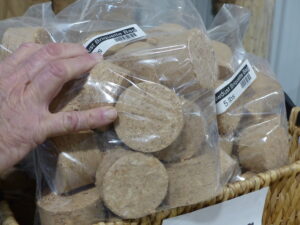
-
Value added and no waste.
-
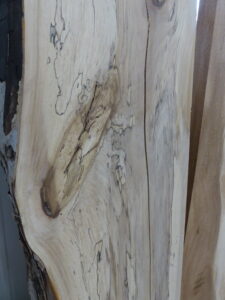
-
Fungi-laced wood
A Way to Add Character to a Room
The materials from our recent downstairs bathroom renovation are mostly manmade. That’s understandable, as the surfaces need to be easily cleaned and resist moisture. But the room needed the character of wood. So, we bought an oak board from Knot Just Lumber to cover a small area of plaster. It adds the warmth of nature to an otherwise utilitarian space.
Hidden Gems
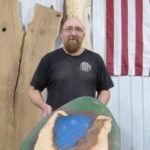
Fusing old and new technology.
Knot Just Lumber is a local store we found by accident. The staff consult, have working spaces and classes for customers and specialize in epoxy with the wood to create gorgeous pieces for homes. Their prices are reasonable, especially compared to national stores or online sources. Similar local stores are scattered across the country. Finding them can be tricky but hobbyist woodworkers know where they are and anyone can Google hardwood lumber and they might learn of a nearby place to buy gorgeous local wood.
Resources
One of our favorite resources to learn the diverse characteristics of dozens of different species of native and exotic woods is the book WOOD! Identifying and Using Hundreds of Woods Worldwide, by Eric Meier.
-
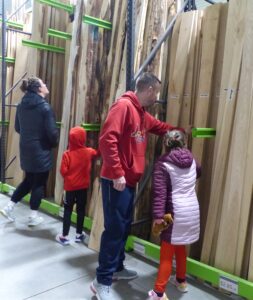
-
Families taking in the lumber.
-
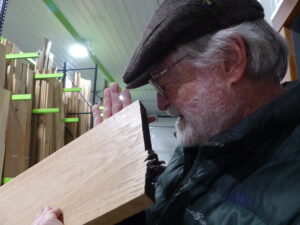
-
Assessing lumber.
-
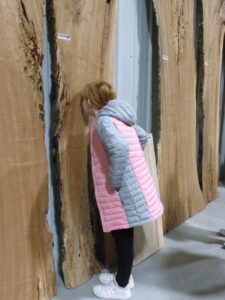
-
wood has a characteristic smell.
by Winding Pathways | Oct 26, 2023 | (Sub)Urban Homesteading, Garden/Yard, Nature, Trees
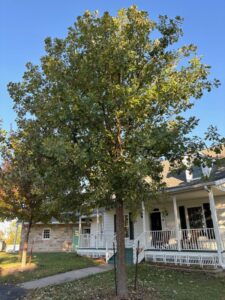
Magnet bur oak in front yard
We didn’t intend to create a magnet when we planted a skinny bur oak in our front yard 13 years ago.
It created a startling experience one October evening when Marion went to the porch to check the weather. A large furry form dropped from the nearby tree and scurried away in the gathering darkness. A woodchuck? Not likely. They work the day shift. Later we caught the mystery animal in the bean of a flashlight as it returned to the magnet tree. A husky raccoon that again retreated in haste when it saw us.
Over the next several days we watched squirrels and woodchucks forage on the acorns. At dusk bucks and does with yearlings eagerly, yet watchfully, gobbled up acorns. In between, turkeys wandered by to forage. Blue jays dropped out of the tree onto the ground and carried off husky acorns to store for winter.
Why Oaks Attract Wildlife
Our October oak was a perfect magnet. While most area oaks were acorn-bare, our youthful front yard tree was loaded with them. They were huge, sweet, and free of the weevils that often consume acorns before exiting through tiny holes.
Blue jays, wild turkeys, woodchucks, raccoons, squirrels, and deer consider October acorns prime carbohydrate-loaded food. When few oaks, scattered around, bear a heavy crop, wild animals beeline to those loaded with nuts. That’s why our tree was a magnet drawing in a stream of wildlife until every acorn was consumed.
-
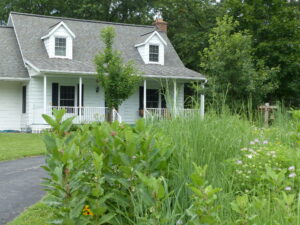
-
Small oak and maple.
-
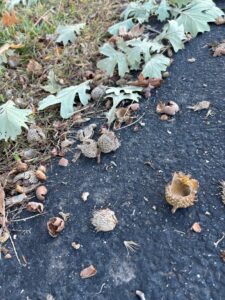
-
Prolific Bur Oak acorns
-
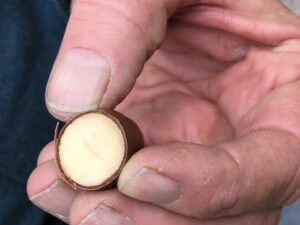
-
White oak acorns have lower tannic acid.
White oak types have leaves with rounded lobes. These include white, bur, and swamp white oaks. Their big acorns are low in tannic acid and are a prized animal and human food. Most trees only bear a heavy crop every few years with acorns that sprout almost as soon as they hit the ground. If not eaten soon weevils find them.
Black oak types have leaves with pointed lobes. Their acorns are loaded with bitter tannin. Often wild animals only feast on them after nearby sweeter white oak-type acorns have all been eaten. Black oak-type acorns wait until next spring to sprout. Perhaps their tannic acid helps them remain uneaten until they sprout months after falling from the tree.
Optimal Places to Plant Oaks
When planted in an ideal location with full sun and rich soil, an oak will begin producing acorns when it’s seven to ten years old. Our front yard tree had a light crop the past few years, but when it reached its 13th year it was loaded with nuts. It was a true magnet that lured wildlife in from far and wide. We enjoyed watching many animals dine on acorns produced by a tree we planted.
by Winding Pathways | Jul 27, 2023 | Nature, Travel/Columns, Trees
Always Something New To Learn
Although we’ve lived in Iowa for over 40 years, we never knew so much history crowded into a small town in the mid-1800s not long after settlement. Our visit to the Lewelling Quaker Museum in Salem, Iowa, brought us up to speed on history. The small museum tells a fascinating, little-known history that impacted people far beyond Iowa’s borders. They focus on three significant areas.
Quakers
The Museum’s formal name is the Lewelling Quaker Museum. These peaceful people moved to the area during the decades prior to the Civil War. Among their many beliefs was a strong aversion to slavery. Neighboring Missouri settlers owned slaves just 20 miles south of Salem.
-
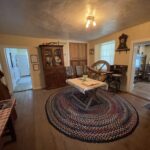
-
Decorated in the era of the 1800s.
-
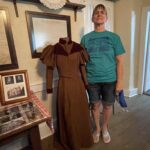
-
_Note Height Difference
-

-
Way to make music
The Underground Railroad
Salem area Quakers, joined by others of various faiths, were a significant part of the Underground Railroad that helped escaped slaves move north to legal safety in Canada. In the museum, located in an old home, we were able to enter the tiny crawl space beneath the kitchen where slaves hid from slave catchers. The process must have been scary for both slaves and those who helped them. Captured slaves were returned to their owner for likely punishment and continued to live in bondage. Whites who helped risked arrest and incarceration. Yet, the Underground railroad persisted and helped many people gain freedom.
-
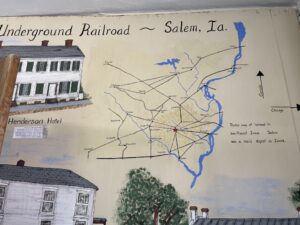
-
Salem was a major depot.
-
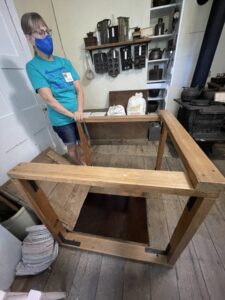
-
A rug and kitchen table covered the closed trap door.
Fruit
The Lewelling Family were nursery people who cultivated and sold fruit trees. They developed several productive varieties of cherries and apples. In the early days of the Oregon Trail travel fever infected the Lewellings. They modified a wagon to hold tiny fruit tree slips and made the arduous trek over the Great Plains and mountains all the way to the Willamette Valley. Most of the baby trees survived the trip and were used to start the Pacific Northwest’s famed fruit industry. People enjoy different fruits and apple varieties to this day in part because of the families that carried the tiny fruit slips west.
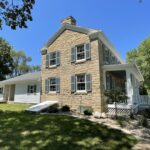
18″ thick walls.
The volunteer-operated Lewelling Quaker Museum is open for tours Sunday afternoons from 1-4 pm May through September and by appointment at other times and dates. We found our visit fascinating and encourage others to go. Salem is located a few miles south of Mount Pleasant, Iowa, in the SE corner of the state. For information check lewelling.org.


































